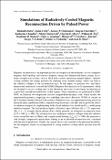| dc.contributor.author | Datta, Rishabh | |
| dc.contributor.author | Crilly, Aidan | |
| dc.contributor.author | Chittenden, Jeremy P. | |
| dc.contributor.author | Chowdhry, Simran | |
| dc.contributor.author | Chandler, Katherine | |
| dc.contributor.author | Chaturvedi, Nikita | |
| dc.contributor.author | Myers, Clayton E. | |
| dc.contributor.author | Fox, William R. | |
| dc.contributor.author | Hansen, Stephanie B. | |
| dc.contributor.author | Jennings, Chris A. | |
| dc.contributor.author | Ji, Hantao | |
| dc.contributor.author | Kuranz, Carolyn C. | |
| dc.contributor.author | Lebedev, Sergey V. | |
| dc.contributor.author | Uzdensky, Dmitri A. | |
| dc.contributor.author | Hare, Jack D. | |
| dc.date.accessioned | 2024-06-21T18:13:36Z | |
| dc.date.available | 2024-06-21T18:13:36Z | |
| dc.date.issued | 2024-04 | |
| dc.identifier.issn | 0022-3778 | |
| dc.identifier.issn | 1469-7807 | |
| dc.identifier.uri | https://hdl.handle.net/1721.1/155295 | |
| dc.description.abstract | Magnetic reconnection is an important process in astrophysical environments, as it reconfigures magnetic field topology and converts magnetic energy into thermal and kinetic energy. In extreme astrophysical systems, such as black hole coronae and pulsar magnetospheres, radiative cooling modifies the energy partition by radiating away internal energy, which can lead to the radiative collapse of the reconnection layer. In this paper, we perform two- and three-dimensional simulations to model the MARZ (Magnetic Reconnection on Z) experiments, which are designed to access cooling rates in the laboratory necessary to investigate reconnection in a previously unexplored radiatively cooled regime. These simulations are performed in GORGON, an Eulerian two-temperature resistive magnetohydrodynamic code, which models the experimental geometry comprising two exploding wire arrays driven by 20 MA of current on the Z machine (Sandia National Laboratories). Radiative losses are implemented using non-local thermodynamic equilibrium tables computed using the atomic code Spk, and we probe the effects of radiation transport by implementing both a local radiation loss model and 𝑃1/3
multi-group radiation transport. The load produces highly collisional, super-Alfvénic (Alfvén Mach number 𝑀𝐴≈1.5
), supersonic (Sonic Mach number 𝑀𝑆≈4−5
) strongly driven plasma flows which generate an elongated reconnection layer (Aspect Ratio 𝐿/𝛿≈100
, Lundquist number 𝑆𝐿≈400
). The reconnection layer undergoes radiative collapse when the radiative losses exceed the rates of ohmic and compressional heating (cooling rate/hydrodynamic transit rate = 𝜏−1cool/𝜏−1𝐻≈100
); this generates a cold strongly compressed current sheet, leading to an accelerated reconnection rate, consistent with theoretical predictions. Finally, the current sheet is also unstable to the plasmoid instability, but the magnetic islands are extinguished by strong radiative cooling before ejection from the layer. | en_US |
| dc.description.sponsorship | National Science Foundation (NSF) | en_US |
| dc.description.sponsorship | NNSA | en_US |
| dc.publisher | Cambridge University Press | en_US |
| dc.relation.isversionof | 10.1017/s0022377824000448 | en_US |
| dc.rights | Creative Commons Attribution-Noncommercial-ShareAlike | en_US |
| dc.rights.uri | http://creativecommons.org/licenses/by-nc-sa/4.0/ | en_US |
| dc.source | Author | en_US |
| dc.title | Simulations of radiatively cooled magnetic reconnection driven by pulsed power | en_US |
| dc.type | Article | en_US |
| dc.identifier.citation | Datta R, Crilly A, Chittenden JP, et al. Simulations of radiatively cooled magnetic reconnection driven by pulsed power. Journal of Plasma Physics. 2024;90(2):905900215. | en_US |
| dc.contributor.department | Massachusetts Institute of Technology. Plasma Science and Fusion Center | |
| dc.relation.journal | Journal of Plasma Physics | en_US |
| dc.eprint.version | Author's final manuscript | en_US |
| dc.type.uri | http://purl.org/eprint/type/JournalArticle | en_US |
| eprint.status | http://purl.org/eprint/status/PeerReviewed | en_US |
| dc.identifier.doi | 10.1017/S0022377824000448 | |
| dspace.date.submission | 2024-06-21T15:23:27Z | |
| mit.journal.volume | 90 | en_US |
| mit.journal.issue | 2 | en_US |
| mit.license | OPEN_ACCESS_POLICY | |
| mit.metadata.status | Authority Work and Publication Information Needed | en_US |
